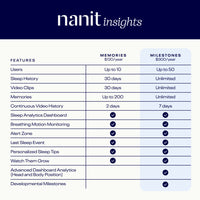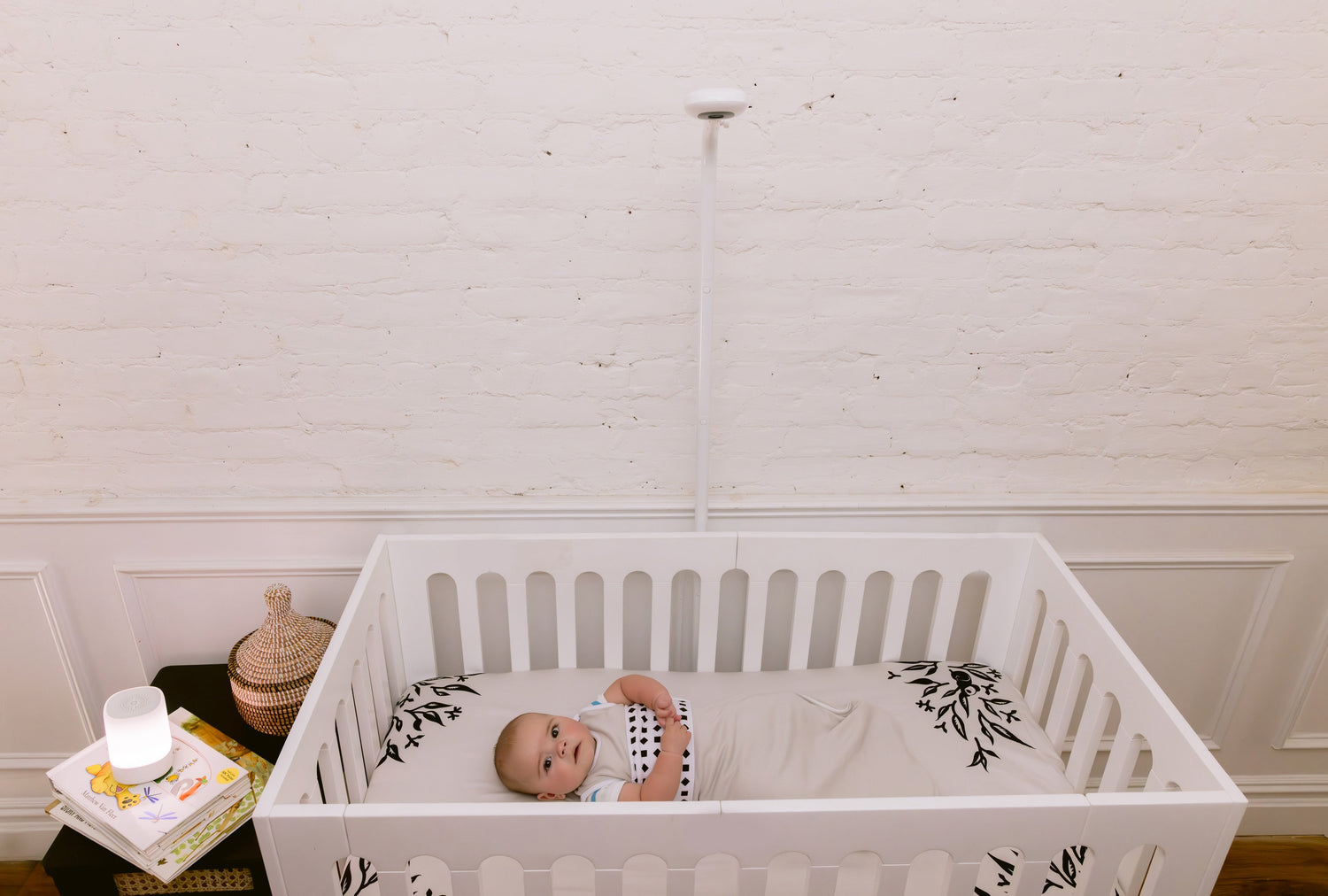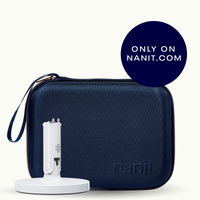Sharing the closeness of skin-to-skin contact with your newborn is a special experience for you and for your baby, sweet, snuggle time that can also calm your baby and help regulate their body temperature.
What does it mean if their breathing rate gets faster all of a sudden when moments before they were breathing calmly? Is there a reason to be concerned?
There are many explanations for why a baby’s breathing pattern and rate suddenly changes—and it’s helpful to know what those reasons are and when these patterns are normal, rather than cause for concern. Here we equip you with the knowledge you need to navigate these moments.
4 reasons babies breathe quickly while sleep
As a new parent, your newborn’s health is always top of mind. So it can be scary if your baby is breathing faster than usual, and you didn’t know that it could be normal.
Infants can experience fast breathing due to a range of factors.. So, here are 4 common reasons why your baby may be breathing quickly
1. Their respiratory system is still developing
A baby’s respiratory system continues to develop throughout childhood. Changes in breathing rate depending on age or activity can be expected and are not always a reason for concern. However, you should contact your pediatrician if you are concerned or if you notice any of the following symptoms:
- Breathing consistently for more than 60 breaths per minute
- A pulling or tugging around the ribs when breathing, with an appearance of working hard to catch their breath
- Breath-holding episode that lasts more than 20 seconds
2. They’re transitioning between sleep cycles.
During an infant's REM sleep cycles, their breathing pattern can be irregular or even include a pause for 5- 10 seconds. These pauses are followed by a period of rapid breathing that lasts 10 to 15 seconds, before returning to a normal rate. This phenomenon is called periodic breathing and is common amongst newborns. It can occur while asleep and in a quiet alert state. It’s not usually indicative of any underlying health issues, and most babies outgrow periodic breathing in the first few months of life.
3. They’re crying in their sleep.
It takes a lot out of your little one each time they let out a heartfelt wail. And while you might assume that babies only cry when they’re awake, babies can cry in their sleep as well. The cries during sleep are not necessarily calls for help but occur as they are shifting from one sleep cycle to another one. As they transition from one stage to the next, they sometimes cry out or wriggle around. Crying gives a baby’s respiratory system a work out, elevating their oxygen demand, causing a baby’s breathing rates to briefly increase.
4. They have an underlying health condition.
If your baby is ill with a respiratory infection, there may be a change in their breathing rate. Reach out to your pediatrician to discuss any concerns you have about your baby’s breathing.
- Respiratory infections. Babies are born with a complex immune system that is still developing. While babies have some protection against common illnesses due to transferred maternal immunity during pregnancy, they are susceptible to the effects of certain respiratory bugs. These infections can cause inflammation or congestion in a baby’s nasal passages or lungs which can result in an increased effort in breathing. As a result, babies may breathe more quickly to maintain their oxygenation.
It helps to learn to recognize the signs that your baby is sick. If your baby is congested, there are a few simple ways to help improve their breathing comfort; more easily, using a humidifier and placing nasal saline drops into their nose to lubricate the mucus, making it easier to sneeze out.
Why do newborns breathe fast?
Most healthy adults’ breathe at a rate of 12 to 20 breaths per minute. Newborns, however, often breathe at a much quicker rate due to their smaller lung capacity. An adult's larger lung capacity allows for greater reserves of oxygen in between breaths.
What is a normal breathing pattern in babies?
So, what’s considered a normal baby respiratory rate?
A newborn’s typical breathing rate while awake is between 40 and 60 breaths per minute. During deep states of sleep, their breathing rate may decrease to a little less than 40 breaths per minute.
When to be concerned about rapid breathing
While occasional irregularities, like brief pauses or rapid breathing, are common, certain signs may indicate abnormal breathing. Watch for consistent fast breathing (over 60 breaths per minute), grunting, flaring nostrils, or a bluish tint around the lips. These could be signs of respiratory distress and should not be ignored.
Tips to monitor your baby's breathing motion
As a new parent, you’re likely watching your baby as they sleep, making sure they are breathing comfortably. But there are simpler solutions that can alleviate your worry and help you get needed sleep.
Use a baby monitor you can trust
Set up a baby monitor, like Nanit Pro Camera, and it will do the heavy lifting for you.
The Nanit Pro Camera offers you a bird’s eye view of your sleeping baby. With our Breathing Wear and the Nanit App, you’ll also have access to sensor-free breathing motion monitoring, so you can track your little one’s breathing motion as they sleep.
Here’s how it works:
- Step 1: Place your sleepy baby in an age-appropriate piece of Breathing Wear.
- Step 2: Position the Nanit Pro Camera for optimal monitoring (make sure it has a clear view of your baby’s chest). While they sleep, the Nanit Pro Camera tracks the rise and fall of the Breathing Wear’s specialized fabric, analyzing your baby’s movements and monitoring your little one’s breathing in real-time.
- Step 3: View your baby’s breathing motion on the Nanit app from the comfort of your bed, the couch, or anywhere you are. In addition, you’ll also receive timely notifications should the monitor no longer detect breathing motion.
Stay connected while your baby sleeps
Nanit Pro Camera does the job of monitoring your baby while they sleep, giving you peace of mind, and allowing you to get a good night’s rest, too. You’ll receive notifications if breathing motion is no longer detected, as well as data on your baby’s movements, breathing, growth, and more.
Trust your instincts
At the end of the day, you are your baby’s greatest advocate. If you’re concerned about their breathing patterns, it’s always recommended to seek medical guidance from your pediatrician.
From scheduling an appointment with your pediatrician to speaking with a nurse or doctor on the phone, it’s always better to err on the side of caution when it comes to questions you have about your baby’s health.
How Nanit’s data supports parents
The Nanit Pro Camera provides the helpful benefit of gathering your little one’s sleep analytics and presenting them in an easy-to-understand format, useful for you to check out and pass on to your pediatrician should the need arise.
With instant access to your baby’s respiratory patterns, your child’s doctor may be able to better understand your child’s respiratory health and arrive at a more accurate diagnosis if they get sick or experience any health concerns. Nanit is not meant to be a replacement for professional medical advice or care. Rather, it’s an added tool that can complement a health provider’s expertise.
Sleep peacefully with Nanit
Nanit gives parents the confidence that their little ones are sleeping soundly and safely day and night.
With the Nanit Pro Camera, you’ll have a 24-hour virtual bedside assistant carefully monitoring your baby’s every breath and movement. Let us check in on your baby’s breathing for you, giving you complete peace of mind.
Key takeaways
- There are several reasons for rapid breathing in babies. Common causes of babies' increased breathing rates during sleep include babies’ still-developing respiratory systems, sleep cycle changes, occasional mid-sleep cries, or a respiratory Illness.
- Know what normal infant breathing rates are. Newborns typically breathe at a faster rate than adults, ranging from approximately 40 to 60 times per minute. It is important to count a newborn's respiratory rate for a full minute to account for their varying breathing rate.
- Invest in reliable baby monitoring. Invest in a trustworthy baby monitor. The Nanit Pro Camera has breathing motion monitoring capabilities to track your baby's sleep patterns and breathing movements in real-time.
Sources:
NIH. Embryology, Pulmonary. https://www.ncbi.nlm.nih.gov/books/NBK544372/
Stanford Medicine. Breathing Problems. https://www.stanfordchildrens.org/en/topic/default?id=breathing-problems-90-P02666
Healthy Children. Stages of Newborn Sleep. https://www.healthychildren.org/English/ages-stages/baby/sleep/Pages/phases-of-sleep.aspx
ACAAI. Allergy Symptoms in Children. https://acaai.org/allergies/allergies-101/who-gets-allergies/children/
Boston’s Children Hospital. What is apnea of prematurity? https://www.childrenshospital.org/conditions/apnea-prematurity
RCH. How are children different? https://www.rch.org.au/trauma-service/manual/how-are-children-different/









































